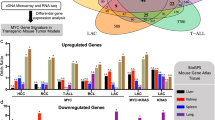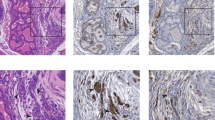Abstract
Mxi1 belongs to the Mad (Mxi1) family of proteins, which function as potent antagonists of Myc oncoproteins1,2,3,4. This antagonism relates partly to their ability to compete with Myc for the protein Max and for consensus DNA binding sites and to recruit transcriptional co-repressors4,5,6. Mad(Mxi1) proteins have been suggested to be essential in cellular growth control and/or in the induction and maintenance of the differentiated state6,7. Consistent with these roles, mxi1 may be the tumour-suppressor gene that resides at region 24–26 of the long arm of chromosome 10. This region is a cancer hotspot, and mutations here may be involved in several cancers, including prostate adenocarcinoma8,9,10. Here we show that mice lacking Mxi1 exhibit progressive, multisystem abnormalities. These mice also show increased susceptibility to tumorigenesis either following carcinogen treatment or when also deficient in Ink4a. This cancer-prone phenotype may correlate with the enhanced ability of several mxi1-deficient cell types, including prostatic epithelium, to proliferate. Our results show that Mxi1 is involved in the homeostasis of differentiated organ systems, acts as a tumour suppressor in vivo, and engages the Myc network in a functionally relevant manner.
This is a preview of subscription content, access via your institution
Access options
Subscribe to this journal
Receive 51 print issues and online access
$199.00 per year
only $3.90 per issue
Buy this article
- Purchase on Springer Link
- Instant access to full article PDF
Prices may be subject to local taxes which are calculated during checkout




Similar content being viewed by others
References
Ayer, D. E., Kretzner, L. & Eisenman, R. N. Mad: a heterodimeric partner for Max that antagonizes Myc transcriptional activity. Cell 72, 211–222 (1993).
Hurlin, P. J. et al. Mad3 and Mad4: novel Max-interacting transcriptional repressors that suppress c-myc dependent transformation and are expressed during neural and epidermal differentiation. EMBO J. 14, 5646–5659 (1995).
Zervos, A. S., Gyuris, J. & Brent, R. Mxi1, a protein that specifically interacts with Max to bind Myc-Max recognition sites. Cell 72, 223–232 (1993).
Schreiber-Agus, N. et al. An amino-terminal domain of Mxi1 mediates anti-Myc oncogenic activity and interacts with a homolog of the yeast transcriptional repressor SIN3. Cell 80, 777–786 (1995).
Ayer, D. E., Lawrence, Q. A. & Eisenman, R. N. Mad-Max transcriptional repression is mediated by ternary complex formation with mammalian homologs of yeast repressor Sin3. Cell 80, 767–776 (1995).
Schreiber-Agus, N. & DePinho, R. A. Repression by the Mad(Mxi1)-Sin3 complex. Bioessays(in the press).
Henriksson, M. & Luscher, B. Proteins of the Myc network: essential regulators of cell growth and differentiation. Adv. Cancer Res. 68, 109–182 (1996).
Edelhoff, S. et al. Mapping of two genes encoding members of a distinct subfamily of MAX interacting proteins: MAD to human chromosome 2 and mouse chromosome 6, and MXI1 to human chromosome 10 and mouse chromosome 19. Oncogene 9, 665–668 (1994).
Shapiro, D. N. et al. Assignment of the human MAD and MXI1 genes to chromosomes 2p12-p13 and 10q24-q25. Genomics 23, 282–285 (1994).
Wechsler, D. S. et al. Localization of the human Mxi1 transcription factor gene (MXI1) to chromosome 10q24-q25. Genomics 21, 669–672 (1994).
Adams, J. M. et al. The c-myc oncogene driven by immunoglobulin enhancers induces lymphoid malignancy in transgenic mice. Nature 318, 533–538 (1985).
Harris, A. W. et al. Transgenic mouse models for hematopoietic tumorigenesis. Curr. Top. Microbiol. Immunol. 141, 82–93 (1988).
Yukawa, K. et al. Strain dependency of B and T lymphoma development in immunoglobulin heavy chain enhancer (E mu)-myc transgenic mice. J. Exp. Med. 170, 711–726 (1989).
Raimondi, S. C. et al. Cytogenetics of childhood T-cell leukemia. Blood 72, 1560–1566 (1988).
Cowley, B. D. J, Chadwick, L. J., Grantham, J. J. & Calvet, J. P. Elevated proto-oncogene expression in polycystic kidneys of the C57BL/6J (cpk) mouse. J. Am. Soc. Nephrol. 1, 1048–1053 (1991).
Trudel, M., D'Agati, V. & Constantini, F. C-myc as an inducer of polycystic kidney disease in transgenic mice. Kidney Int. 39, 665–671 (1991).
Dedeoglu, I. O. et al. Spectrum of glomerulocystic kidneys: a case report and review of the literature. Ped. Path. Lab. Med. 16, 941–949 (1996).
Foley, K. P. et al. Targeted disruption of the MYC antagonist MAD1 inhibits cell cycle exit during granulocyte differentiation. EMBO J. 17, 774–785 (1998).
Gerlach, C. et al. Ki-67 immunoexpression is a robust marker of proliferative cels in the rat. Lab. Invest. 77, 697–698 (1997).
Hecker, E. et al. International symposium: skin carcinogenesis in man and in experimental models. J. Cancer Res. Clin. Oncol. 118, 321–328 (1992).
Serrano, M. et al. Role of the INK4a locus in tumor suppression and cell mortality. Cell 85, 27–37 (1996).
Serrano, M. et al. Inhibition of ras-induced proliferation and cellular transformation by p16INK4. Science 267, 249–252 (1995).
Pomerantz, J. et al. The INK4a tumor suppressor gene product, p19ARF, interacts with MDM2 and neutralizes MDM2's inhibition of p53. Cell 92, 713–723 (1998).
Li, J. et al. PTEN, a putative protein tyrosine phosphatase gene mutated in human brain, breast, and prostate cancer. Science 275, 1943–1947 (1997).
Eagle, L. R. et al. Mutation of the MXI1 gene in prostate cancer. Nature Genet. 9, 249–255 (1995).
Kawamata, N. et al. Point mutations of the Mxi1 gene are rare in prostate cancers. Prostate 29, 191–193 (1996).
Gray, I. C. et al. Loss of the chromosomal region 10q23-25 in prostate cancer. Cancer Res. 55, 4800–4803 (1995).
Prochownik, E. V. et al. Commonly occurring loss and mutation of the MXI1 gene in prostate cancer. Genes Chromosom. Cancer(in the press).
Jenkins, R. B., Qian, J., Lieber, M. M. & Bostwick, D. G. Detection of c-myc oncogene amplification and chromosomal anomalies in metastatic prostatic carcinoma by fluorescence in situ hybridization. Cancer Res. 57, 524–531 (1997).
Thompson, T. C. et al. Transgenic models for the study of prostate cancer. Cancer 71, 1165–1171 (1993).
Acknowledgements
We thank A. Skoultchi and members of the DePinho lab for comments; D.Gebhardt, for assistance and advice with FACS studies; L. Chin for graphic-art assistance; C. J. Chang for statistical analysis; and J. Lauridsen for administrative assistance. H.-W.L. and Y.M. were supported by NIH training grants. R.G. was supported by an MSTP training grant. N.S.-A. is a Special Fellow of the Leukemia Society of America. C.C.-C. is supported by grants from the NIH. R.A.D. is supported by grants from the NIH and by the Irma T. Hirschl Award. We acknowledge support from the Albert Einstein Cancer Center Core.
Author information
Authors and Affiliations
Corresponding author
Rights and permissions
About this article
Cite this article
Schreiber-Agus, N., Meng, Y., Hoang, T. et al. Role of Mxi1 in ageing organ systems and the regulation of normal and neoplastic growth. Nature 393, 483–487 (1998). https://doi.org/10.1038/31008
Received:
Accepted:
Issue Date:
DOI: https://doi.org/10.1038/31008
This article is cited by
-
Suppression of tumor metastasis by a RECK-activating small molecule
Scientific Reports (2022)
-
UBE2O targets Mxi1 for ubiquitination and degradation to promote lung cancer progression and radioresistance
Cell Death & Differentiation (2021)
-
Identifying specific proteins involved in eggshell membrane formation using gene expression analysis and bioinformatics
BMC Genomics (2015)
-
Downregulation of Max dimerization protein 3 is involved in decreased visceral adipose tissue by inhibiting adipocyte differentiation in zebrafish and mice
International Journal of Obesity (2014)
-
Knockin of SV40 Tag oncogene in a mouse adenocarcinoma of the prostate model demonstrates advantageous features over the transgenic model
Oncogene (2005)
Comments
By submitting a comment you agree to abide by our Terms and Community Guidelines. If you find something abusive or that does not comply with our terms or guidelines please flag it as inappropriate.



